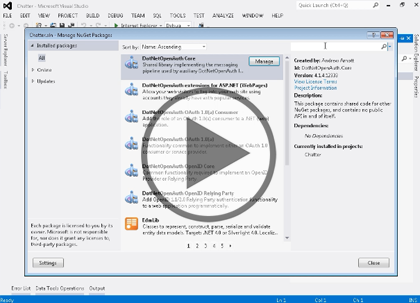Course description
There are all kinds of tools available for web developers these days. Even the oldest tools are still relatively young in technology. In the vast landscape of options, how do you choose the best solution?This course will help you to understand the pain of the past and the promise of the future. You will see how the ASP.NET Framework has harnessed the MVC pattern to solve a variety of problems. Then you will see how the ASP.NET Web Forms model is a framework for web application development. Then you will dive into how an MVC application works.
Prerequisites
This course assumes that you are familiar and experienced with Microsoft’s .NET Framework and ASP.NET development tools. You should be familiar with Web development and understand how HTTP and HTML work to produce Web pages for the user. You should have strong experience with .NET Framework 4.0 or later programming. You should have experience with Visual Studio 2012. Experience with building database applications using these tools will be helpful, although not strictly necessary.
Learning Paths
This course will help you prepare for the following certifications and exams:
MCSD: SharePoint Applications
MCSD: Web Applications
70-486: Developing ASP.NET MVC Web Applications
This course is part of the following LearnNowOnline SuccessPaths™:
Building MVC Web Applications
Meet the expert
Philip Ledgerwood has been a software developer for fifteen years. He currently works primarily in .NET technologies producing custom software for organizations of all sizes. He has also done extensive training for those same organizations in both technical and business process topics. Philip is a strong advocate of Lean and agile software development and spends most of his time helping companies interested in the value those practices can bring to their development efforts. He does this through a combination of training and working "in the trenches" as a developer on these teams, keeping a hand in the academic side of emerging technology and practices while also directly applying it in real projects to bring real business value.
Course outline
Introduction
Not So Ancient History (27:11)
- Introduction (00:24)
- Not So Ancient History (01:29)
- HTML (02:36)
- Demo: HTML Document (03:19)
- ASP (Active Server Pages) (02:11)
- Demo: Active Server Page (03:23)
- ASP.NET Web Forms (03:14)
- Demo: ASP.NET Web Forms (03:34)
- Demo: How Web Forms Work (04:00)
- ASP.NET MVC (00:55)
- Demo: ASP.NET MVC (01:45)
- Summary (00:15)
MVC and Web Forms (26:28)
- Introduction (00:21)
- ASP.NET MVC Clarification (01:41)
- MVC Architecture (03:00)
- Demo: MVC Structure (03:29)
- ASP.NET MVC and Web Forms (03:52)
- Demo: Web Forms vs ASP.NET MVC (04:04)
- Demo: MVC Functionality (01:24)
- Tenets of MVC (03:50)
- Web Forms or MVC? (04:29)
- Summary (00:12)
MVC Applications (30:17)
- Introduction (00:16)
- Getting to Know an MVC App (02:40)
- MVC Project Template (03:05)
- Demo: Starting a MVC Project (02:38)
- Exploring Sample Application (00:17)
- Project Structure (01:43)
- Demo: MVC Project Folders (02:06)
- Application Web Addresses (01:16)
- Demo: MVC Web Addresses (02:10)
- Controllers and Action Methods (02:02)
- Demo: Controllers (01:54)
- Demo: Action Methods (01:04)
- Views (01:55)
- Demo: Views (02:07)
- Models (00:52)
- Demo: Models (00:47)
- Supporting Testability (01:09)
- Demo: Unit Test (01:51)
- Summary (00:15)



